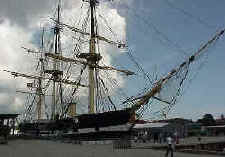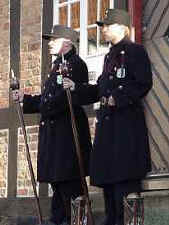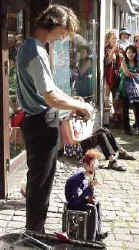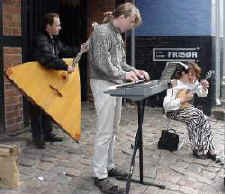The town of Ebeltoft was chartered in 1301 by King Erik
Menved. The municipal charter gave Ebeltoft the right to engage in trade and
artisan work. It will celebrate its 700th birthday soon. The town
itself is hundreds of years older than its official beginning, and for many
years was very poor. Because the seamen and artisans that lived there had no
money to build new houses, many of the town's buildings are patched rather
than rebuilt and still look essentially as they did centuries ago.
|
 Many
of the houses look as though they are ready to fall down, with their
centers bowed out and their lines uneven. We had lunch at Den Skœve Bar
(The Crooked Bar), which dates back to the 17th century. Many
of the houses look as though they are ready to fall down, with their
centers bowed out and their lines uneven. We had lunch at Den Skœve Bar
(The Crooked Bar), which dates back to the 17th century.
|
 The tiny streets in the oldest part of town are cobblestone. There is a
shopping area of several blocks that is for pedestrians only. Several of
the oldest buildings are now restaurants and galleries, so they are open
to the public. Ebeltoft has attracted a community of artists, especially
those who work with glass.
The tiny streets in the oldest part of town are cobblestone. There is a
shopping area of several blocks that is for pedestrians only. Several of
the oldest buildings are now restaurants and galleries, so they are open
to the public. Ebeltoft has attracted a community of artists, especially
those who work with glass.
|
|
 Fregatten
Jylland (Frigate Jutland) was named for the peninsula upon which
Denmark sits. The world's longest wooden frigate, it was launched
in 1860, as wooden battleships gave way to newer iron steam-powered
ships. The ship participated in the Battle of Helgoland in 1864 against
a Prussian-Austrian squadron and came away victorious. Visitors can go
into nearly every part of the ship, inside and outside. The hull was
constructed by laying oak planks in strategic ways to reduce the weight
of the vessel and maintain its strength in battle. The ship's engine
enabled the ship to move at 11 knots. The 400 horsepower engine operated
at about 56 rpm. By comparison, Swept Away motors at 8 knots at about
2500 rpm using its 110 horsepower engine. In 1960, the frigate's arrival
and restoration in Ebeltoft helped to revitalize the shipping and ferry
services to Ebeltoft. Fregatten
Jylland (Frigate Jutland) was named for the peninsula upon which
Denmark sits. The world's longest wooden frigate, it was launched
in 1860, as wooden battleships gave way to newer iron steam-powered
ships. The ship participated in the Battle of Helgoland in 1864 against
a Prussian-Austrian squadron and came away victorious. Visitors can go
into nearly every part of the ship, inside and outside. The hull was
constructed by laying oak planks in strategic ways to reduce the weight
of the vessel and maintain its strength in battle. The ship's engine
enabled the ship to move at 11 knots. The 400 horsepower engine operated
at about 56 rpm. By comparison, Swept Away motors at 8 knots at about
2500 rpm using its 110 horsepower engine. In 1960, the frigate's arrival
and restoration in Ebeltoft helped to revitalize the shipping and ferry
services to Ebeltoft.
|
 In
1576, the citizens of Ebeltoft built their first town hall. Two hundred
years later, the old hall was so dilapidated that they replaced it with
a new one, including a clock tower and a dank prison. We visited the
town hall on a Saturday, which meant we needed to see it while it was
not occupied by weddings. The two gentlemen on the right are the
watchmen, which were once common in Danish market towns. These watchmen
walk to the town hall steps three times each evening and sing a song. Of
course, we didn't understand a single word, because it's all in Danish. In
1576, the citizens of Ebeltoft built their first town hall. Two hundred
years later, the old hall was so dilapidated that they replaced it with
a new one, including a clock tower and a dank prison. We visited the
town hall on a Saturday, which meant we needed to see it while it was
not occupied by weddings. The two gentlemen on the right are the
watchmen, which were once common in Danish market towns. These watchmen
walk to the town hall steps three times each evening and sing a song. Of
course, we didn't understand a single word, because it's all in Danish.
Because so many people gather to see the watchmen, performers come out
before the show and entertain the crowd. |
|
 This
performer's marionette has movable fingers and changing facial
expressions. Here he plays (really plays) a ukulele (very badly.) The
puppet would point its finger to count the money, then point again to
count the people watching, and shake his head and grimace. More people
would then give him money. This
performer's marionette has movable fingers and changing facial
expressions. Here he plays (really plays) a ukulele (very badly.) The
puppet would point its finger to count the money, then point again to
count the people watching, and shake his head and grimace. More people
would then give him money.
|

We saw these musicians play Mozart's "A Little Night Music" and
Debussy's "La Mer" on this very odd combination of instruments.
|
 This
comic performed before and after the watchmen each evening. He juggled
fire while riding the very tall unicycle you see in the background. He
waved to us with five ping-pong balls in his mouth, then juggled them
all, from his mouth, with three balls in the air at once. This
comic performed before and after the watchmen each evening. He juggled
fire while riding the very tall unicycle you see in the background. He
waved to us with five ping-pong balls in his mouth, then juggled them
all, from his mouth, with three balls in the air at once.
|


